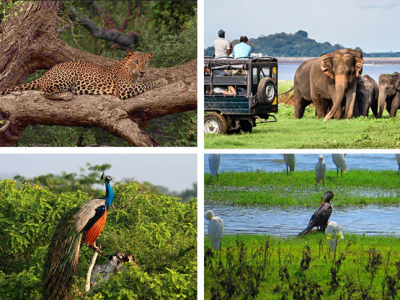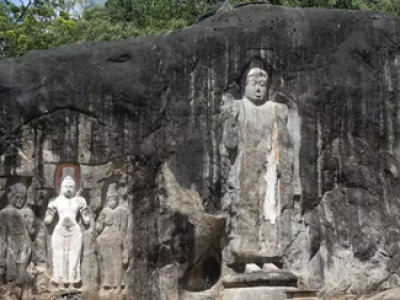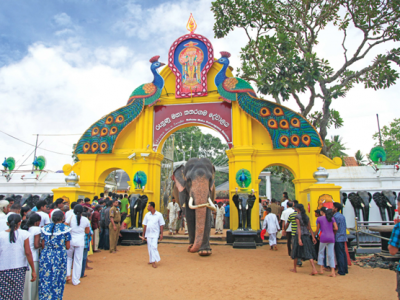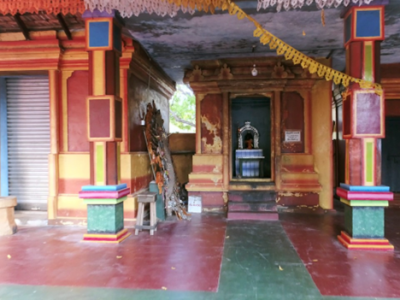The Best Places to Visit in Yala National Park
Here are the top places to visit in the iconic Yala National Park. Make sure you witness these amazing places during your Yala trip.
Because of its proximity to Yala National Park, which is among the most frequented of Sri Lanka’s national parks, Yala has become one of the most well-known tourist sites in the country. The 1268 square kilometers that make up Yala are home to stunning light woods, verdant grasslands, and saline lagoons, all of which attest to the island’s abundance of species. Elephants, leopards, crocodiles, buffaloes, aquatic birds, and monkeys are among the most often seen animals in this area.
As far as leopard sightings go, the west is where you’ll have the most luck. Numerous spectacular attractions may be found around Sri Lanka thanks to the country’s varied landscapes and rich wildlife.
Must-see places in Yala National Park
The shoreline and coral reef of Yala National Park are indeed remarkable, but the park also has various historic ruins, temples, and rock carvings from as far back as the third century BC. The Kumana National Park is a common stop on the journey both Hindu and Sinhalese worshippers take to the Kataragama shrine. Some of Yala National Park’s favorite parts include:
1. The park in general
Although it may seem obvious, we just must include this magnificent national park in our article. About 305 kilometers from Colombo, the Yala National Park stretches over 97,878 acres and is divided into the publicly accessible Ruhana and Kumana National Parks to the west and east, respectively. Because a river separates the two areas, traveling between them is arduous. Yala National Park is Sri Lanka’s second-biggest national park. And it has semi-arid thorn scrubs, deep forests, mangroves, and spectacular coral reefs along the coast. The largest national park in Sri Lanka is Wilpattu National Park.
In addition to its more than 250 bird species, 46 reptile species, 44 animal species, and 18 amphibian species, Yala National Park is well-known for its greatest concentration of 25 leopards. The other animals graze about in groups of 100–200, including elephants, wild buffalo, and sloth bears. The wood pigeon, black-capped bulbul, brown-capped babbler, crimson-fronted barbet, jungle fowl, and grey hornbill are just some of the other six bird species that may be found in Sri Lanka. Also abundant are populations of Toque macaque and Red Slender Loris, both of which are prosimians.

2. Magul Maha Viharaya
South of Sithulpawwa, in Yala National Park, lies the historic Buddhist temple of Magul Maha Viharaya, where Vihara Maha Devi and King Kaban Tissa were married. The temple is a “must-see” because of its attractive architecture.
On the vihara grounds, you can still see the foundations of the “Magul Maduwa,” which served as the setting for the wedding. The Viharaya complex, said to have been constructed by King Kavanthissa in the second century BC, is over 10,000 acres and has the remnants of a bo-maluwa, palace, monastery, stupas, and ponds.
3. Buduruwagala
One of Yala’s top attractions, Buduruwagala is home to some of the world’s oldest and largest Buddha statues, dating back over a millennium and standing at a staggering 15 meters in height. The huge Buddha statue features tiny carved figures on its side, and its unusual cemented robe is a vibrant shade of orange.

4. Kebiliththa
Kebiliththa, a village in the fourth section of Yala National Park, is a popular destination for visitors seeking a peaceful environment in which to practice their Hindu or Buddhist faiths. Many people go to Kebiliththa in search of serenity because they believe it to be the preferred place of meditation for the gods Kataragama and Skanda.
A modest and old Siyambala tree, around 9 feet high, which sprung from the branch of a giant tamarind tree, serves as the devalaya’s focal point and is surrounded by a few statues. It is often said that one must plan ahead, refrain from eating any eggs, fish, or meat, and present their sacrifices to the Kebiliththa with the highest confidence and reverence if they ever want to be granted an audience with the deity.
5. Kataragama
Kataragama, a historical village next to the park, delivers a calming mix of seriousness, purity, beautiful vegetation, and community. Kataragama is one of Sri Lanka’s most significant pilgrimage sites, and members of all faiths, including those who follow the Vedas, Islam, Hinduism, and Buddhism, come here to pay their respects in huge numbers every July and August.
Daily rituals at the temple include making sacrifices between 4.30 and 10.30 in the morning and again at 6.30 in the evening, while the yearly procession has Kawadi dancers and fire walkers paying honor to the gods.
If you happen to be at Kataragama, look out for the many hawkers selling garlands and flowers, as well as the fruit platters piled high with coconuts, mangoes, watermelons, etc

6. Sithulpawwa
The Sithulpawwa Rock Temple, located in Yala, is 2,200 years old and is known as one of the oldest rock monasteries in the world. It is estimated that 12,000 monks formerly lived there. Located in a wide region, the Sithulpawwa Rajamaha Viharaya is home to many cave temples, Buddha statues, stupas, and image homes, as well as old paintings painted on the rock’s surface using a thin plastic coating; these paintings are mostly red and yellow.
7. Okanda Devalaya
It is generally agreed that Kumana National Park’s formal entrance is located in Okanda Devalaya, a rural village. There is a common myth that God Skanda arrived in Sri Lanka in a golden boat that eventually turned into a rock. Tourists often stop for a break at the Okanda crossroads before continuing to Kumana and Yala National Parks.

Wrapping up
You should now have a better idea of which sites in the illustrious Yala National Park you should prioritize seeing. You should absolutely include each of these locations on your list of must-sees. What’s more, if you get an early start on your sightseeing, you can see everything on this list in a single day.


Customer
Nice post. I used to be checking continuously this blog and I am inspired! Very useful information specially the remaining part 🙂 I maintain such info a lot. I used to be seeking this particular info for a long timelong time. Thank you and good luck.
Customer
Does your site have a contact page? I’m having a tough time locating it but, I’d like to send you an e-mail. I’ve got some creative ideas for your blog you might be interested in hearing. Either way, great site and I look forward to seeing it expand over time.
Customer
Thank you for some other magnificent article. Where else may just anyone get that kind of information in such a perfect way of writing? I have a presentation next week, and I am at the look for such information.
Customer
Wow, this piece of writing is good, my sister is analyzing such things, so I am going to let know her.
Customer
I am extremely inspired with your writing talents and alsowell as with the layout for your blog. Is this a paid topic or did you customize it yourself? Either way stay up the nice quality writing, it’s rare to see a nice blog like this one nowadays..
Customer
What i do not realize is in fact how you’re not really a lot more smartly-appreciated than you may be right now. You are so intelligent. You understand therefore significantly when it comes to this matter, produced me in my opinion believe it from numerous various angles. Its like men and women don’t seem to be fascinated unless it’s something to accomplish with Woman gaga! Your personal stuffs excellent. Always take care of it up!
Customer
Excellent, what a website it is! This weblog gives helpful information to us, keep it up.
Customer
I simply could not depart your site prior to suggesting that I really enjoyed the standard information a person supply in your visitors? Is going to be back incessantly in order to check out new posts
Customer
I enjoy reading through a post that will make people think. Also, thank you for allowing for me to comment!
Customer
Usually I do not read article on blogs, however I wish to say that this write-up very pressured me to try and do so! Your writing taste has been amazed me. Thank you, quite great article.
Customer
Excellent blog here! Also your website quite a bit up fast! What host are you the use of? Can I am getting your associate link in your host? I desire my site loaded up as fast as yours lol
Customer
Its like you read my mind! You seem to know so much approximately this, like you wrote the book in it or something. I feel that you simply could do with some p.c. to force the message house a bit, however other than that, this is great blog. An excellent read. I’ll definitely be back.
Customer
you are in point of fact a good webmaster. The web site loading speed is incredible. It sort of feels that you are doing any unique trick. In addition, The contents are masterpiece. you have performed a magnificent activity in this topic!
Customer
Can I simply say what a relief to find somebody that actually knows what they’re talking about on the web. You certainly know how to bring an issue to light and make it important. More and more people must look at this and understand this side of the story. I can’t believe you aren’t more popular since you definitely have the gift.
Customer
This is my first time go to see at here and i am in fact happy to read all at alone place.
Customer
I like what you guys are usually up too. This sort of clever work and exposure! Keep up the great works guys I’ve you guys to my personal blogroll.
Customer
After looking at a number of the blog articles on your web page, I really like your way of blogging. I book-marked it to my bookmark site list and will be checking back soon. Please check out my web site as well and let me know how you feel.
Customer
Hmm it appears like your website ate my first comment (it was extremely long) so I guess I’ll just sum it up what I had written and say, I’m thoroughly enjoying your blog. I as well am an aspiring blog blogger but I’m still new to the whole thing. Do you have any helpful hints for inexperienced blog writers? I’d definitely appreciate it.
Customer
I love your blog.. very nice colors & theme. Did you create this website yourself or did you hire someone to do it for you? Plz reply as I’m looking to create my own blog and would like to know where u got this from. thanks
Customer
I visited multiple sites except the audio quality for audio songs present at this web site is in fact wonderful.
Customer
No matter if some one searches for his essential thing, so he/she wants to be available that in detail, thus that thing is maintained over here.
Customer
Hey! Quick question that’s completely off topic. Do you know how to make your site mobile friendly? My site looks weird when viewing from my iphone. I’m trying to find a theme or plugin that might be able to correct this problem. If you have any suggestions, please share. Appreciate it!